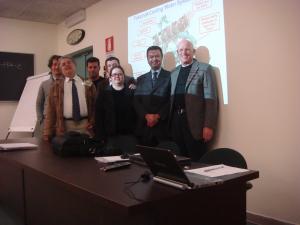Pisa University to support cooling water design
10 Dec 2010
-
Warren Curd and Giovanni Dell'Orco, ITER Cooling Water Section
Not leaning at all—the Pisa meeting participants: Alessandro del Nevo, Francesco D'Auria, Lorenzo Colombino, Dino Araneo, Martina Adorni, Giovanni Dell'Orco and Warren Curd.
A delegation from the ITER Cooling Water System Section recently visited the Dipartimento di Ingengeria Meccanica, Nucleare e della Produzione (DIMNP) in Pisa, Italy. The University is in close proximity to the famous leaning tower. During the meeting between the Section and DIMNP, the possibility of future collaborations with the University of Pisa was discussed utilizing direct academic experience for the ITER cooling water system design.
The DIMNP is a research structure of the University of Pisa, with more than 50 academic and research staff members and about 30 technical administrative staff. Since its institution, the department has been characterized by a strong orientation towards collaborations with Italian and European industries in applicative research projects with wide scientific and technological significance.
The DIMNP Nuclear Section has long experience in computer code analysis, in particular using the RELAP code for the thermal-hydraulic transient analysis in fission reactors; computational fluid dynamics to evaluate the various regimes of velocity, pressure and temperature; and specific codes such as the Enel Code for analysis of radionuclide transport (ECART) to evaluate the dust re-suspension during a loss of pressure accident in the ITER vacuum vessel (STARDUST campaign, developed in collaboration with ENEA UTFUS Frascati).
Based on this relevant expertise, a future collaboration between DIMNP and the ITER cooling water group would be possible on the steady state and transient thermal-hydraulics analyses to simulate the ITER cooling water system during plasma operations to be performed by Fathom and RELAP codes.
Within the University of Pisa, the Gruppo di Ricerca San Piero a Grado was created in December 2003 to maintain and improve the Italian competencies in the field of the nuclear technology, performing R&D, engineering services and training activities according to the tradition of the Department of Mechanics, Nuclear and Production Engineering (DIMNP) and of the University of Pisa (UNIPI).


